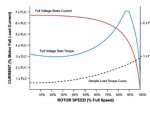Sparky2791
Senior Member
- Location
- Allentown, PA
Good Day,
I am working on a project for a client who has a 300HP motor he needs connected for a saw mill. The power company is requesting a design from the customer (My client) to show that the motor will not produce a large power draw across the service in the event the motor is running and the saw hits something in the wood it is cutting which will slow the motor down bringing the motor closer to locked rotor current. We’ve all cut through wood with our 1 HP circular saw in the garage and if we hit a knot or nail in the wood the saw slows down or locks up and dims the lights in the garage, now imagine that time 300. I have been doing electrical design for 20 plus years and know how to spec a VFD drive to start this motor to avoid the in-rush current during start up in an effort to protect the power companies incomming service but this is the first time I have been tasked with insuring this does not happen after the motor has been started and is running at full capacity. I can understand the concern considering the locked rotor current of a 480V – 3Phase, 300HP motor is 2200A. That will likely cause quite a problem for the power companies customers. Is there a certain type of drive available to help prevent this from happening. Looking for some assistance as to ma manufacturer I can use as a resource for this. This is an older saw mill which is being connected at a new facility so apparently it is not ‘built into’ the saw.
Any assistance on this ‘learn something new every day’ moment for me would be appreciated.
Thanks for the input.
I am working on a project for a client who has a 300HP motor he needs connected for a saw mill. The power company is requesting a design from the customer (My client) to show that the motor will not produce a large power draw across the service in the event the motor is running and the saw hits something in the wood it is cutting which will slow the motor down bringing the motor closer to locked rotor current. We’ve all cut through wood with our 1 HP circular saw in the garage and if we hit a knot or nail in the wood the saw slows down or locks up and dims the lights in the garage, now imagine that time 300. I have been doing electrical design for 20 plus years and know how to spec a VFD drive to start this motor to avoid the in-rush current during start up in an effort to protect the power companies incomming service but this is the first time I have been tasked with insuring this does not happen after the motor has been started and is running at full capacity. I can understand the concern considering the locked rotor current of a 480V – 3Phase, 300HP motor is 2200A. That will likely cause quite a problem for the power companies customers. Is there a certain type of drive available to help prevent this from happening. Looking for some assistance as to ma manufacturer I can use as a resource for this. This is an older saw mill which is being connected at a new facility so apparently it is not ‘built into’ the saw.
Any assistance on this ‘learn something new every day’ moment for me would be appreciated.
Thanks for the input.



